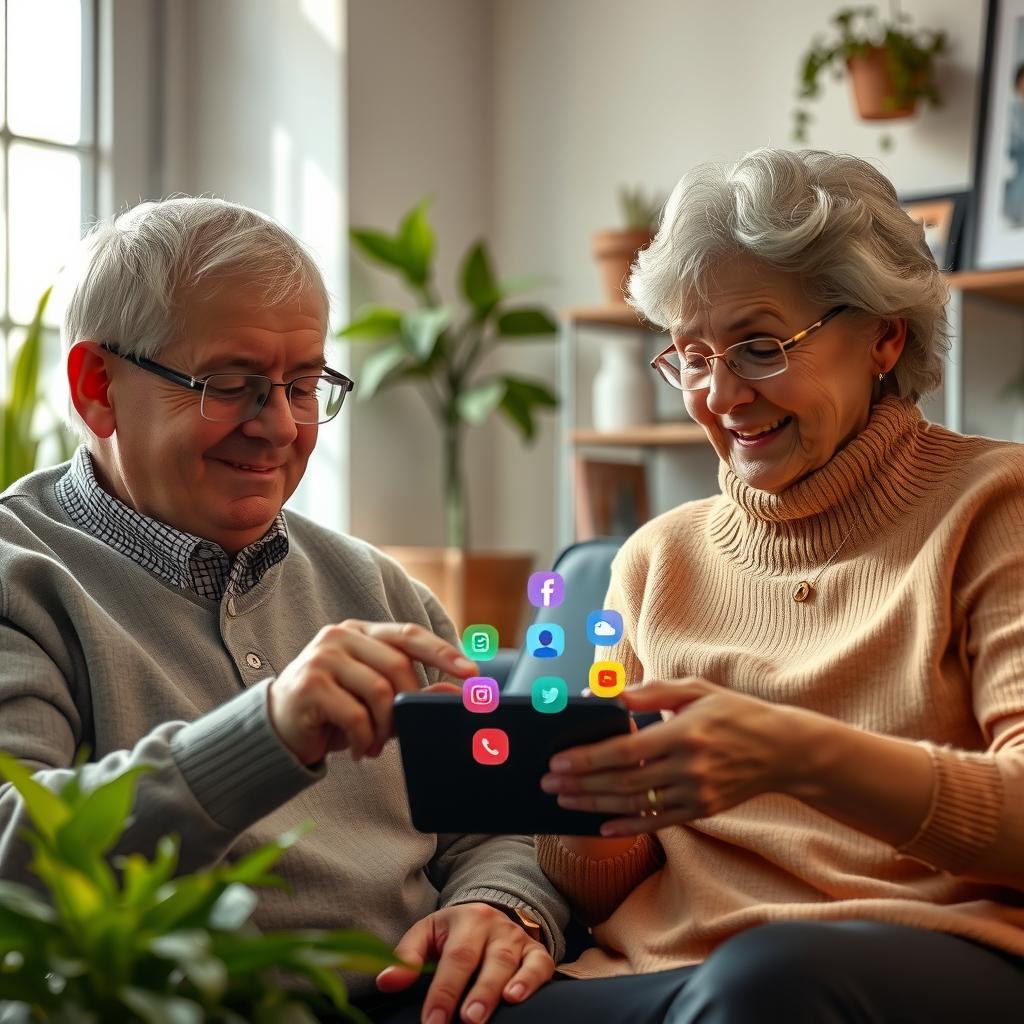In an era where technology permeates every aspect of daily life, a significant gap persists in the design of digital products that cater to elderly users. This demographic often encounters challenges when interacting with various devices and applications, leading to frustration and disengagement. As society increasingly shifts towards digital solutions, it becomes imperative to address the unique needs of senior citizens through intuitive user interfaces. The crux of this problem lies in creating designs that not only accommodate but also empower older adults—facilitating their engagement with technology rather than alienating them.
The core value of understanding user experience for elderly individuals is twofold: enhancing accessibility and ensuring digital inclusion. By focusing on features that promote ease-of-use, designers can create environments where seniors feel confident navigating new technologies without extensive training or support. Through thoughtful consideration of elements such as font size, color contrast, and navigational simplicity, developers have the opportunity to transform potentially overwhelming experiences into enjoyable interactions.
Moreover, employing rigorous usability testing specifically tailored for senior technology users reveals invaluable insights into their behaviors and preferences. Such research allows designers to identify pain points within existing systems while simultaneously validating effective design solutions that resonate with elderly individuals’ abilities and expectations. In doing so, product teams can foster a more inclusive approach toward technological advancement.
This blog post will explore various strategies for crafting effective interfaces aimed at older adults by emphasizing principles rooted in intuitive design practices. Readers will discover how prioritizing usability not only benefits seniors but ultimately enhances overall product effectiveness across diverse user groups. Join us as we delve deeper into designing meaningful experiences that bridge the generational divide in our rapidly evolving digital landscape—the journey toward accessible technology begins here!

Key Points:
-
User Interface Design for Elderly Users: Designing user interfaces with a focus on elderly users requires understanding the unique challenges they face. Intuitive design principles should be prioritized, ensuring that navigation is straightforward and functionalities are easily accessible. This approach fosters not only usability but also enhances overall user experience, empowering seniors to engage confidently with technology.
-
Usability Testing Tailored to Seniors: Implementing usability testing specifically aimed at senior participants offers crucial insights into their specific needs and preferences. By observing how older adults interact with digital platforms, developers can identify pain points and areas for improvement. This collaborative feedback loop is essential in refining design solutions that cater directly to the requirements of this demographic, ultimately leading to enhanced digital inclusion.
-
Accessibility Through Innovative Solutions: Emphasizing accessibility through innovative design solutions can significantly improve interaction quality for elderly users. Features like large touch targets, high-contrast text options, and voice-assisted commands play critical roles in making technology more approachable. By integrating these elements into user interface design, developers create an environment where seniors feel supported as they navigate various applications and services—thereby bridging generational gaps within our increasingly digital society.

Understanding the Digital Divide: The Importance of Intuitive Design for Seniors
Bridging the Gap with User-Friendly Interfaces
In an increasingly tech-driven world, elderly users often find themselves at a disadvantage due to the complexities associated with modern technology. As society continues to embrace digital advancements, it is crucial to address the digital divide that separates older adults from their more technologically adept counterparts. One significant barrier is the lack of intuitive design in many software applications and devices, which can alienate seniors who may not have grown up with such technologies. This underscores the importance of creating user-friendly interfaces that promote inclusivity and enhance accessibility for all ages.
Moreover, effective user experience (UX) design must prioritize usability testing aimed specifically at senior technology adoption. By understanding common challenges faced by this demographic—such as diminished eyesight, reduced dexterity, and unfamiliarity with digital environments—designers can craft solutions that are both functional and engaging. For instance, larger icons and simplified navigation menus can significantly improve interaction for elderly users who may struggle with smaller touch targets or complex commands.
Accessibility remains a cornerstone principle in developing these designs; thus, employing clear language alongside visual cues becomes essential in ensuring comprehension among seniors. According to user feedback gathered through extensive usability testing sessions, features like voice recognition or customizable settings can empower older adults by tailoring experiences to their unique needs while reducing frustration.
Furthermore, embracing design solutions that encourage engagement rather than intimidation plays a pivotal role in fostering confidence among seniors as they navigate new technologies. Whether it’s smartphones designed with straightforward layouts or websites optimized for ease of use—all contribute toward achieving greater digital inclusion, allowing older generations to access vital information and services seamlessly.
The significance of addressing these design aspects cannot be overstated; when technology becomes more accessible through thoughtful interface development geared towards elderly users, it opens doors previously thought closed due to generational gaps in technological fluency. Ultimately, bridging this gap requires collective awareness about how intuitive design directly impacts user satisfaction across diverse age groups while promoting a sense of belonging within our ever-evolving digital landscape.
Enhancing Usability for Senior Users
Focusing on Simplicity in User Interface Design
The design of user interfaces tailored specifically for elderly users must prioritize simplicity as a central tenet. An effective interface should reduce cognitive load, enabling seniors to engage with technology confidently and independently. This can be achieved through clear visual cues that guide users seamlessly from one task to another. For instance, larger buttons and straightforward navigation paths not only enhance accessibility but also promote a more intuitive design that resonates well with the aging demographic. When testing usability, it is crucial to involve senior participants who can provide insights into their unique challenges and preferences, thereby informing better design solutions that cater directly to their needs. By emphasizing simplicity in layout and labeling, designers can significantly improve the overall user experience for older adults.
The Importance of Clear Visual Cues
Incorporating robust functionalities while maintaining clarity is essential when crafting interfaces for senior users. Clear visual cues—such as contrasting colors, distinct icons, and readable fonts—serve as navigational aids that facilitate ease of use. For example, using universally recognized symbols helps eliminate confusion about functionality; this approach ensures that elderly individuals are not left struggling to interpret ambiguous graphics or text. Moreover, consistent placement of elements across different pages or screens fosters familiarity and reduces anxiety associated with digital interactions among seniors. Implementing these strategies promotes digital inclusion, allowing older adults to embrace technology rather than shy away from it due to frustration or misunderstanding.
Prioritizing Accessibility Features
Accessibility features must be at the forefront of any user interface aimed at enhancing usability for older populations. Elements such as adjustable text sizes, voice commands, and alternative input methods play a crucial role in accommodating varying levels of ability among elderly users. Moreover, ensuring compatibility with assistive technologies further enhances the potential reach of digital products within this demographic group by promoting greater independence in daily tasks—whether it’s managing health appointments or connecting socially online. Regular usability testing involving senior individuals enables developers to refine these features continuously based on real-world feedback rather than assumptions about what might work best.
Robust Functionalities Tailored for Seniors
Lastly, embedding robust functionalities into an intuitive framework creates an engaging experience tailored specifically for seniors navigating modern technology landscapes. Functions like simplified account management systems enhance security while being easy enough for less tech-savvy individuals to navigate without feeling overwhelmed by complexity or jargon-heavy language often found in digital platforms today. Additionally, providing personalized support options—like tutorials designed explicitly around common queries posed by elderly users—not only builds confidence but also encourages ongoing interaction with technological tools which may otherwise seem daunting at first glance.
Enhancing Usability for Elderly Users
The Impact of Involving Seniors in Usability Testing
In the realm of technology design, involving older adults in usability testing serves as a pivotal strategy to refine products tailored for elderly users. By integrating feedback from these individuals during the design process, developers can uncover crucial insights that inform design improvements, ultimately fostering greater confidence among seniors when engaging with modern technology. This collaborative approach not only enhances the overall user experience, but also promotes a sense of ownership and inclusion within this demographic, which has historically faced barriers to digital engagement. As products evolve through iterative testing phases, it becomes increasingly evident that an intuitive design is paramount; elderly users often seek interfaces that are straightforward and accessible, reducing confusion and frustration while navigating various platforms.
Furthermore, embracing constructive criticism from older adults allows designers to hone in on specific challenges they encounter with existing technologies—be it difficulty reading small text or navigating complex menus. Such feedback provides invaluable direction for creating more effective design solutions aimed at improving accessibility across devices. For instance, modifying color contrasts or enlarging touch targets can significantly enhance usability for seniors who may have visual impairments or reduced dexterity. This emphasizes the importance of conducting thorough usability tests that reflect real-world scenarios experienced by senior citizens.
The role of usability testing extends beyond mere functionality; it actively contributes to digital inclusion, empowering seniors by ensuring they have equal opportunities to benefit from technological advancements. When older adults feel their opinions are valued in shaping products intended for their use, it cultivates trust and encourages them to explore new tools confidently—ultimately bridging generational gaps within technology adoption. Thus, leveraging user input not only leads to better-designed interfaces but also fosters an environment where elderly users feel competent and capable in navigating today’s digital landscape.
In conclusion, prioritizing the voices of seniors through systematic usability testing is essential for driving innovation in tech designed specifically for them. By addressing their unique needs through informed iterations based on direct feedback—a practice rooted deeply in understanding user behavior—developers can create more inclusive environments where all ages thrive alongside advancing technologies.
Creating user-friendly interfaces for elderly users is a vital endeavor in today’s digital landscape. To enhance user experience, designers should prioritize the implementation of large touch targets, which are crucial for those who may have limited dexterity or vision. By ensuring that these elements are easily accessible, developers can create more engaging interactions that cater to the needs of older adults navigating technology with varying levels of comfort.
Moreover, straightforward navigation paths play an essential role in fostering intuitive design. When elderly users encounter a simplified interface devoid of unnecessary complexities, they are more likely to feel confident while using various applications and devices. This approach not only promotes accessibility but also encourages seniors to explore functionalities without fear of making mistakes or becoming overwhelmed by convoluted menus.
To further refine digital experiences tailored for seniors, conducting usability testing specifically designed for this demographic is imperative. Engaging older participants during the development process allows designers to uncover unique challenges and preferences that may not be immediately apparent otherwise. By integrating feedback from these evaluations into their work, developers can create robust yet simple design solutions that resonate with elderly users’ specific requirements.
FAQ:
Q: Why is intuitive design important for elderly users?
A: Intuitive design enhances accessibility and overall user experience by simplifying interactions and reducing frustration among seniors when using technology.
Q: How can usability testing benefit the development of senior-focused interfaces?
A: Usability testing tailored for older adults provides valuable insights into their challenges and preferences, allowing designers to make informed adjustments that improve functionality and ease-of-use.
Q: What features should be prioritized in creating user-friendly interfaces for seniors?
A: Key features include large touch targets, clear visual cues like high-contrast text options, straightforward navigation paths, and voice-assisted commands—all aimed at enhancing accessibility for elderly users.

Add a Comment